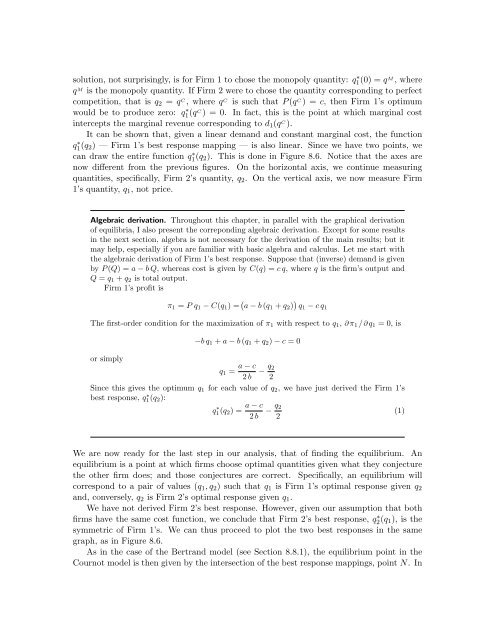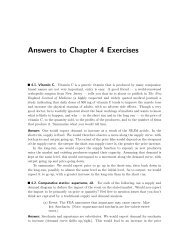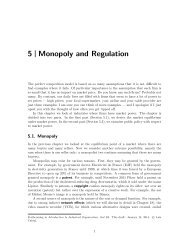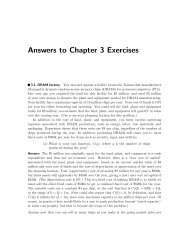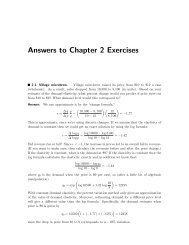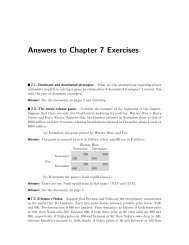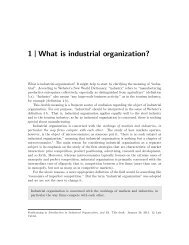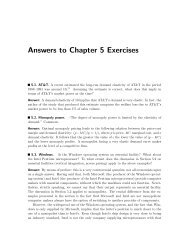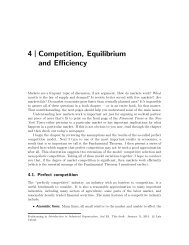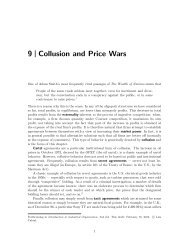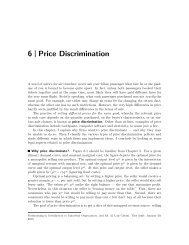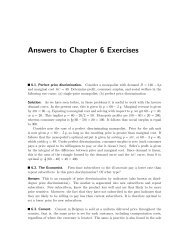8 Oligopoly - Luiscabral.net
8 Oligopoly - Luiscabral.net
8 Oligopoly - Luiscabral.net
You also want an ePaper? Increase the reach of your titles
YUMPU automatically turns print PDFs into web optimized ePapers that Google loves.
solution, not surprisingly, is for Firm 1 to chose the monopoly quantity: q1 ∗(0) = qM , where<br />
q M is the monopoly quantity. If Firm 2 were to chose the quantity corresponding to perfect<br />
competition, that is q 2 = q C , where q C is such that P (q C ) = c, then Firm 1’s optimum<br />
would be to produce zero: q1 ∗(qC ) = 0. In fact, this is the point at which marginal cost<br />
intercepts the marginal revenue corresponding to d 1 (q C ).<br />
It can be shown that, given a linear demand and constant marginal cost, the function<br />
q1 ∗(q 2) — Firm 1’s best response mapping — is also linear. Since we have two points, we<br />
can draw the entire function q1 ∗(q 2). This is done in Figure 8.6. Notice that the axes are<br />
now different from the previous figures. On the horizontal axis, we continue measuring<br />
quantities, specifically, Firm 2’s quantity, q 2 . On the vertical axis, we now measure Firm<br />
1’s quantity, q 1 , not price.<br />
Algebraic derivation. Throughout this chapter, in parallel with the graphical derivation<br />
of equilibria, I also present the correponding algebraic derivation. Except for some results<br />
in the next section, algebra is not necessary for the derivation of the main results; but it<br />
may help, especially if you are familiar with basic algebra and calculus. Let me start with<br />
the algebraic derivation of Firm 1’s best response. Suppose that (inverse) demand is given<br />
by P (Q) = a − b Q, whereas cost is given by C(q) = c q, where q is the firm’s output and<br />
Q = q 1 + q 2 is total output.<br />
Firm 1’s profit is<br />
π 1 = P q 1 − C(q 1 ) = ( a − b (q 1 + q 2 ) ) q 1 − c q 1<br />
The first-order condition for the maximization of π 1 with respect to q 1 , ∂ π 1 /∂ q 1 = 0, is<br />
or simply<br />
−b q 1 + a − b (q 1 + q 2 ) − c = 0<br />
q 1 = a − c − q 2<br />
2 b 2<br />
Since this gives the optimum q 1 for each value of q 2 , we have just derived the Firm 1’s<br />
best response, q1(q ∗ 2 ):<br />
q ∗ 1(q 2 ) = a − c<br />
2 b<br />
− q 2<br />
2<br />
(1)<br />
We are now ready for the last step in our analysis, that of finding the equilibrium. An<br />
equilibrium is a point at which firms choose optimal quantities given what they conjecture<br />
the other firm does; and those conjectures are correct. Specifically, an equilibrium will<br />
correspond to a pair of values (q 1 , q 2 ) such that q 1 is Firm 1’s optimal response given q 2<br />
and, conversely, q 2 is Firm 2’s optimal response given q 1 .<br />
We have not derived Firm 2’s best response. However, given our assumption that both<br />
firms have the same cost function, we conclude that Firm 2’s best response, q2 ∗(q 1), is the<br />
symmetric of Firm 1’s. We can thus proceed to plot the two best responses in the same<br />
graph, as in Figure 8.6.<br />
As in the case of the Bertrand model (see Section 8.8.1), the equilibrium point in the<br />
Cournot model is then given by the intersection of the best response mappings, point N. In


